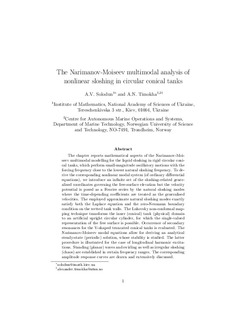The Narimanov-Moiseev multimodal analysis of nonlinear sloshing in circular conical tanks
Journal article
Accepted version

Åpne
Permanent lenke
http://hdl.handle.net/11250/2638741Utgivelsesdato
2020Metadata
Vis full innførselSamlinger
- Institutt for marin teknikk [3397]
- Publikasjoner fra CRIStin - NTNU [37212]
Originalversjon
Studies in Systems, Decision and Control. 2020, 177 267-309. 10.1007/978-3-319-99918-0_9Sammendrag
The chapter reports mathematical aspects of the Narimanov–Moiseev multimodal modelling for the liquid sloshing in rigid circular conical tanks, which perform small-magnitude oscillatory motions with the forcing frequency close to the lowest natural sloshing frequency. To derive the corresponding nonlinear modal system (of ordinary differential equations), we introduce an infinite set of the sloshing-related generalised coordinates governing the free-surface elevation but the velocity potential is posed as a Fourier series by the natural sloshing modes where the time-depending coefficients are treated as the generalised velocities. The employed approximate natural sloshing modes exactly satisfy both the Laplace equation and the zero-Neumann boundary condition on the wetted tank walls. The Lukovsky non-conformal mapping technique transforms the inner (conical) tank (physical) domain to an artificial upright circular cylinder, for which the single-valued representation of the free surface is possible. Occurrence of secondary resonances for the V-shaped truncated conical tanks is evaluated. The Narimanov–Moiseev modal equations allow for deriving an analytical steady-state (periodic) solution, whose stability is studied. The latter procedure is illustrated for the case of longitudinal harmonic excitations. Standing (planar) waves and swirling as well as irregular sloshing (chaos) are established in certain frequency ranges. The corresponding amplitude response curves are drawn and extensively discussed.